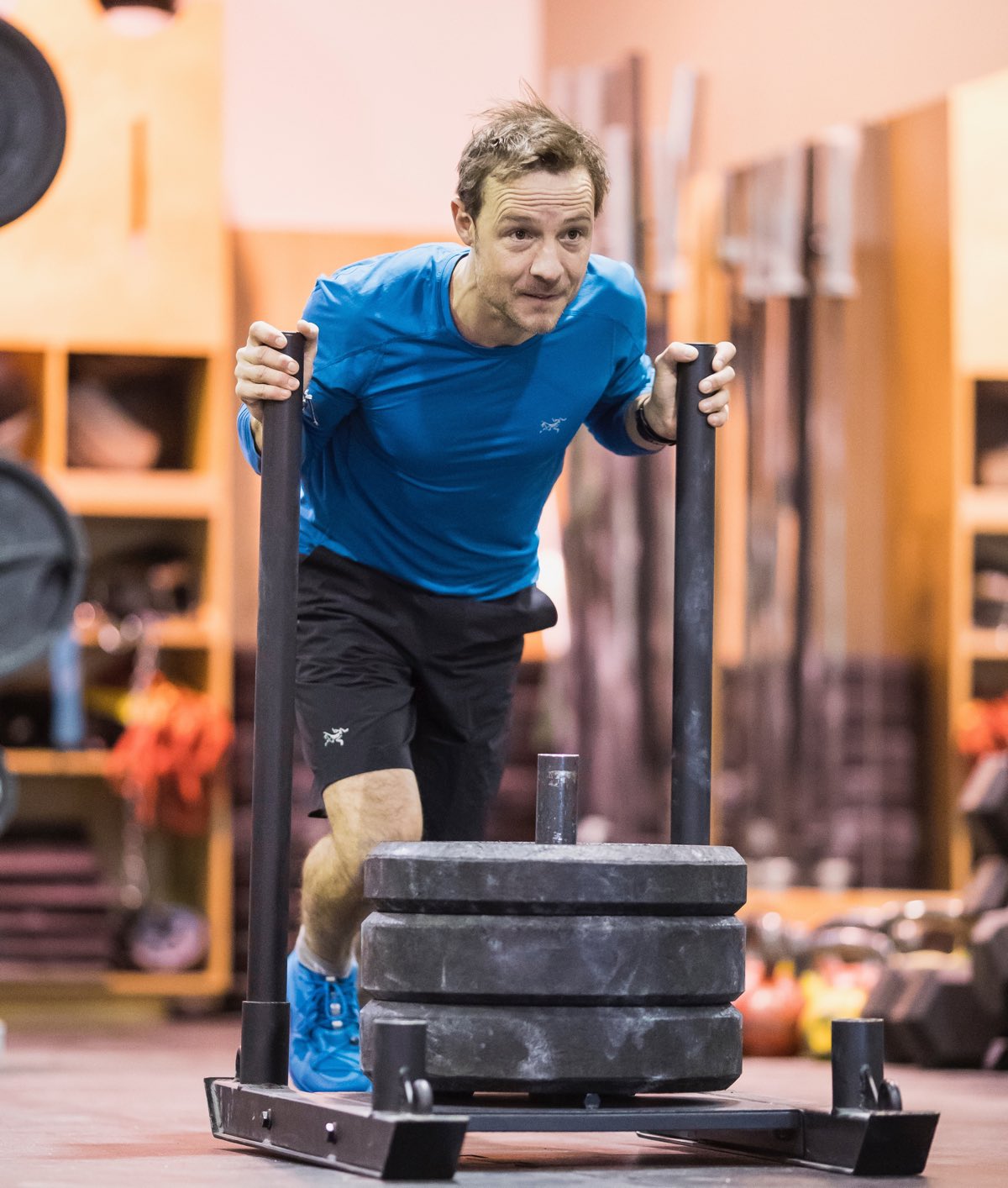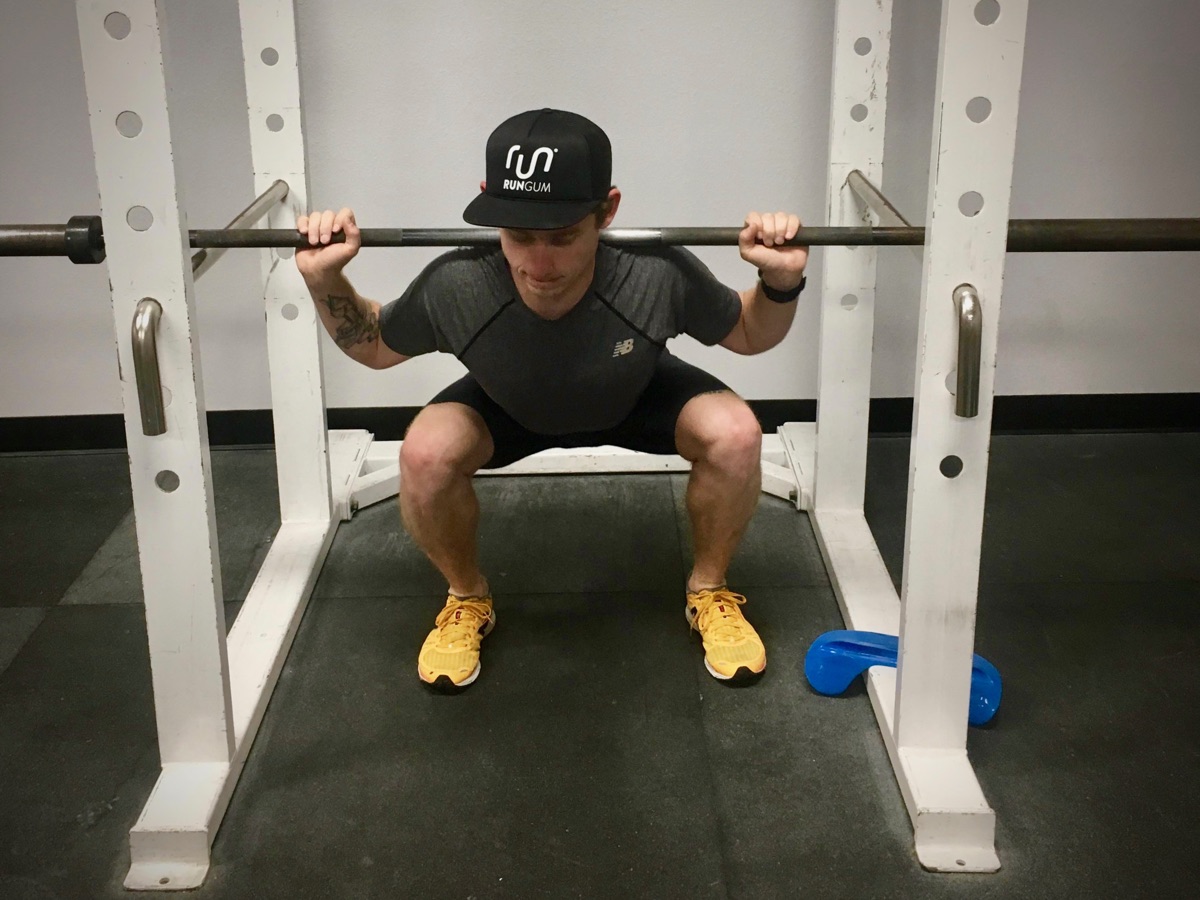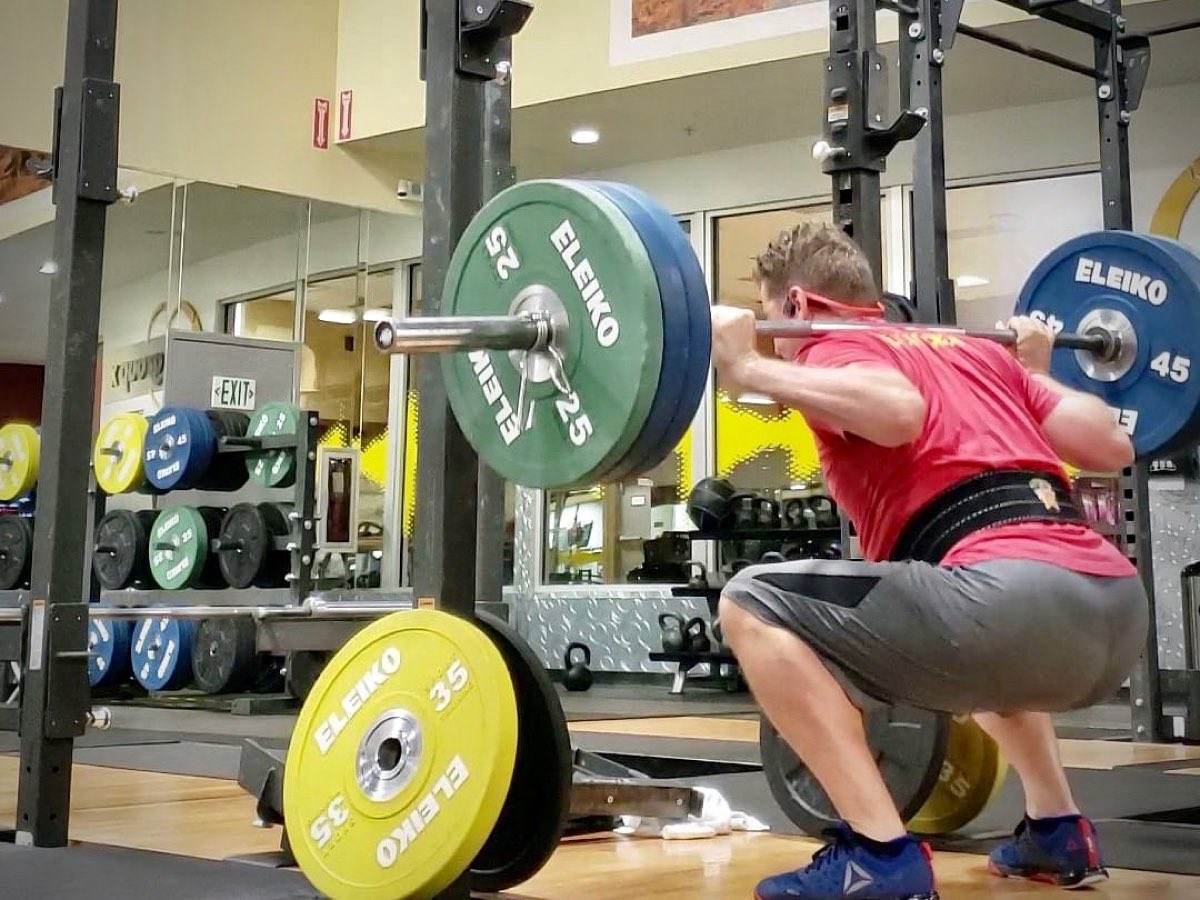“Hey, what do you think about strength training for us endurance runners?” This question occasionally comes across my desk and honestly there is no single, easy answer. Like a lot of physiology, answers to this question operate in shades of grey. What we mean by this is that an intervention–a supplement, workout, fuel source, or recovery technique–might work for one person but not another. Because of the inherent individual variability in physiology, there is rarely one answer to questions like these that is correct for the majority of people.
In this article, we’ll address why endurance runners have historically not spent time in the gym (aside from hating being inside), some myths about strength training, and what the science currently says about how endurance runners can apply strength training to their weekly routines in ways that benefit both their running and overall health.
The History and Basics of Strength Training for Endurance Runners
Strength training, sometimes referred to as resistance training, can mean slightly different things to different people. In general, strength training in its simplest form is exercising with progressively heavier loads to improve muscle strength, power, hypertrophy (growth), and/or endurance.
Let’s note right away that the type of strength training we are talking about in this article is different than the maintenance strength training you might perform with a physical therapist to manage issues of asymmetry, imbalance, and other slight deficits. This kind of training is important for niggle management, but isn’t the strength training we discuss in this article.
Initial research in the 1980s and ‘90s into concurrent strength and endurance training (over simply doing endurance training on its own) showed little cardiovascular and musculoskeletal adaptations that would warrant the time and energy spent on it (1, 15, 19). It was believed then that because of the different physiological demands of strength versus endurance training, training one of these capacities would impair or diminish the other. This is known as the interference phenomenon (2). This combined with general fears in endurance runners around ‘bulking up,’ or adding body mass that decreases VO2max (or essentially decreases your running efficiency), and endurance runners and coaches alike have quite literally been running from the weight room (19).
However, in the last decade, new research is showing that strength training can benefit many kinds of endurance runners–if the right types of it are done in the right doses. This newer research suggests that strength training can enhance endurance-running performance by improving running economy, delaying the onset of fatigue, improving maximal speed, and increasing anaerobic capacity (15).
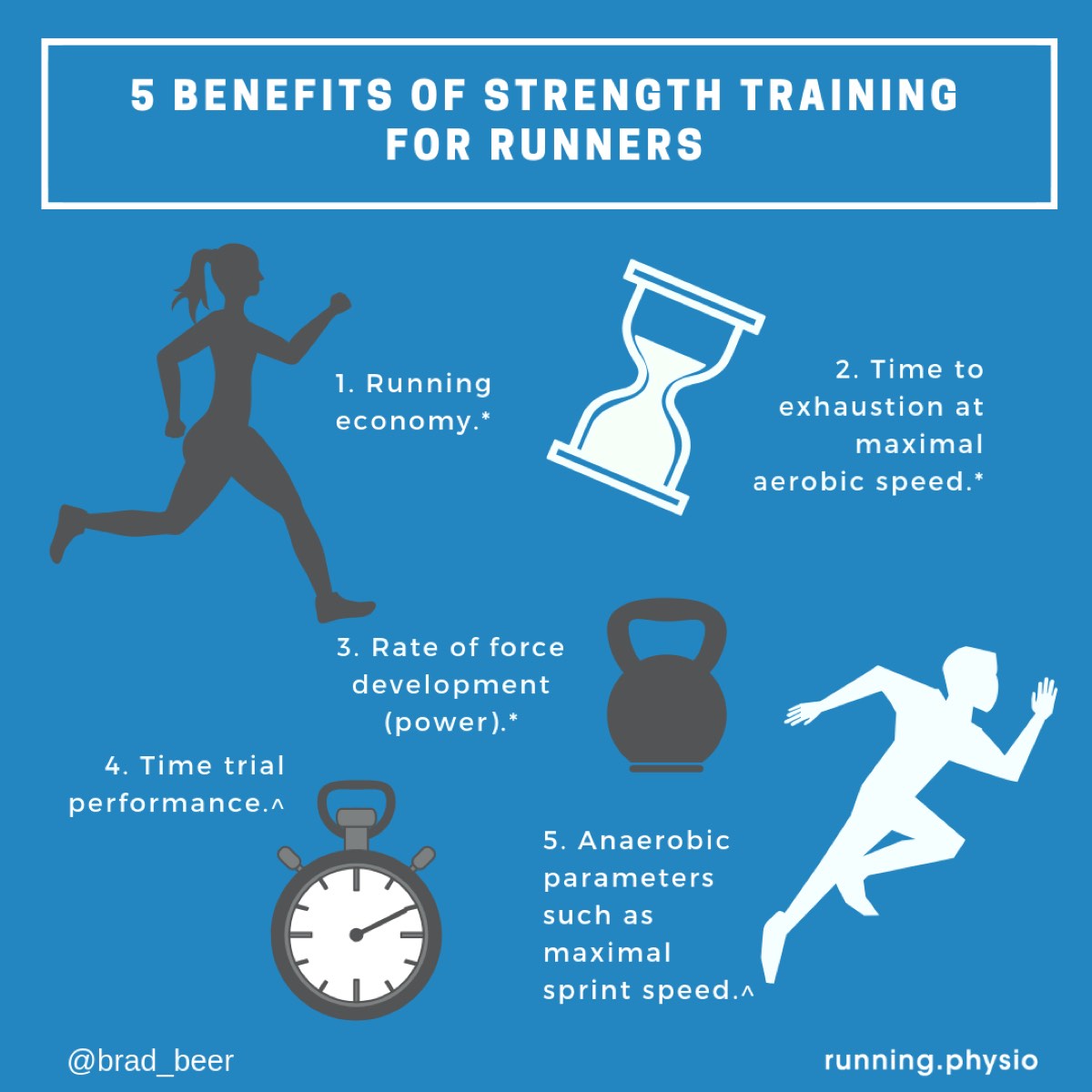
Improvements to endurance-running performance with concurrent strength training have been shown in recent research and include improved running economy, time to exhaustion, rate of force development (power generation), and anaerobic capacity. Image: Goldcoastmarathon.com.au/2019/03/22/5-running-mistakes-to-avoid/
What’s with the 180-degree switch in recommendations over the last decade? When we look back at the design of many early studies, we note they simply had three testing groups: a strength group, an endurance group, and a strength-and-endurance group which combined with no adaptations the two aforementioned programs. Studies designed in this fashion did not explore how to balance both strength and endurance training. Turns out, we scientists don’t always get it right! We miss confounding variables and nuances, and we attribute outcomes to the wrong things. But that we keep learning is also the beauty of science.
We May Be Different: The Ultrarunner’s Strength-Training Conundrum
The last decade of research on concurrent strength and endurance training has focused on endurance running defined as running five kilometers up to the marathon distance. When we break down what contributes to performance at these distances, your day is primarily determined by the maximal power production you can sustain over a given distance, or how much work can you do for how long, physiologically speaking (14).
Experienced ultrarunners know that our events have similar and different demands. There are just plain more variables, both physically and mentally, that affect race-day outcome the longer the race gets. Because of this, some of the improvements strength training delivers to endurance-running performance may or may not translate as directly to ultrarunning. Do keep this in mind as we go forward.

The specific demands of ultramarathon performance are wide ranging. The boxes in bold represent the components thought to be most important for ultramarathon success. Image: Commentaries on Viewpoint: Sacrificing economy to improve running performance—a reality in the ultramarathon? (6)
The Benefits of Strength Training for Endurance Runners
Again, when we look at the past decade of research and the new data showing the positive changes that concurrent strength and endurance training have on endurance-running performance, the factors that stand out are an improvement in running economy, delaying the onset of fatigue, improving your anaerobic capacity, and enhancing your maximal speed.
While these factors are all interrelated (15), our primary focus here is running economy, or the oxygen cost to run at a given submaximal speed, which is influenced by force generation and the speed at which your muscles can contract. Essentially, the higher your running economy is, the less it ‘costs’ to run at any given speed. Studies suggest that effective strength training can increase running economy by 2 to 8% (4).
When broken down to its components, strength training temporarily overloads the neuromuscular system, which allows for an improved ability to recruit motor units (individual muscular units), an increase in muscle-firing frequency, increased muscle-tendon stiffness (allowing you to have more stored energy with each step), and improved intramuscular coordination over time (4). These are all minor physiological changes but together and over time equal running-economy improvement which allows you to run a given pace with a little less effort. This is not dissimilar to what we are trying to accomplish with endurance training alone, but think of these two types of training as additive when it comes to performance.

From a systematic literature review, a list of the potential positive and negative performance outcomes from concurrent strength and endurance training. Image: Rønnestad, B. R., & Mujika, I., 2013 (15)
One of the most likely mechanisms behind the increase in endurance performance from concurrent strength and endurance training is the change that takes place at the level of our muscle fibers, both in their recruitment and modification. First, it seems that after strength training, it takes longer for type II (fast-twitch) muscle fibers to be recruited during endurance activities, favoring type I (slow-twitch) muscle fibers for a longer duration (4).
Second, there is a conversion of muscle fibers after concurrent strength and endurance training when compared to endurance training on its own. This conversion is between two different types of type II muscle fibers, what are called type IIa and type IIx fibers. Type IIx fibers are characterized by their ability to produce high force, power, and speed (lower endurance), whereas type IIa fibers are also fast but they are more fatigue resistant and are better for long-term anaerobic efforts than type IIx fibers. Over 16 weeks of concurrent strength and endurance training, cyclists experienced an increase in type IIa fibers of about 8 to 10% with a slight decline in type IIx fibers (1).
These changes in muscle-fiber recruitment and type as well as the increased muscle-tendon stiffness likely contribute to the increase in rapid-force development, or how fast an athlete can develop force. Altogether, these factors increase our ability to run at a lower ‘cost.’

There are two main types of muscle fibers, type I and type II. Type I are also referred to as slow-twitch fibers and are known for being fatigue resistant. Type II fibers, often referred to as fast-twitch fibers, are known for their rapid firing rate and power production. This study found that after 16 weeks of concurrent strength and endurance training, the muscle-fiber-type distribution changed, with an increase in type IIa muscle fibers (the higher-endurance version of fast-twitch fibers) and a decrease in Type IIx muscle fibers (the high-power, lower-endurance version of the fast-twitch fibers). Image: Aagaard, P., & Andersen, J. L., 2010 (1)
“But Won’t I Bulk Up?”: Addressing Strength-Training Fears
The most common concern I hear from endurance runners is the fear of putting on bulk from strength training. Now there is something to be said for individual variability and genetic predispositions, but resoundingly the scientific literature shows almost a complete lack of muscle hypertrophy (growth) with concurrent strength and endurance training–in correct dosing (4). In studies lasting from 24 to 40 weeks, there were no signs of growth in any gross measurements, however it is still possible that there was muscular growth in individual muscle groups that would be undetectable in girth measurements (4).
Why is this? Muscle hypertrophy with concurrent strength and endurance training seems to be blocked on a molecular level. Essentially, the strength-induced upregulation in protein synthesis and release of a protein called mTOR that otherwise would help build muscle tissue is suppressed by adenosine monophosphate-activated kinase (AMPK), an enzyme that regulates cellular-energy homeostasis that is released in response to endurance exercise (4). It’s a clever cycle given that this means: 1) that in the battle of mTOR versus AMPK, AMPK is the victor, and 2) endurance athletes can increase muscular strength, power generation, muscle-tendon stiffness without the possible negative side effects of mass gain.
As we’ve alluded to a couple times in this article so far, there appears to be a dosing ratio at play. When athletes maintain a 3:1 ratio in the number of endurance sessions to the number of strength sessions they perform, muscle hypertrophy doesn’t occur. So if an athlete wanted to gain mass while still getting some of the benefits of concurrent strength and endurance training, they would need to increase the number of strength sessions or decrease the number of endurance sessions.
Another concern related to muscle hypertrophy is the possibility of capillary-density reduction. Capillary density is important in endurance running because it influences the rate of muscle perfusion, or the rate at which the muscle can receive oxygenated blood (1, 15, 17). If a muscle’s cross-sectional area were to increase without an associated increase in capillary density, this would increase the diffusion distance, or how far oxygenated blood needs to move to get to working muscle tissue. However, without hypertrophy, there is no change in capillary density and so perfusion remains constant.
Strength Training and Injury Prevention
Anecdotally, a lot of athletes will tell you that strength training helps them feel more durable. Now I cannot speak to the scientific community’s thoughts on defining durability, but there is research suggesting that traditional strength training can reduce sports injuries by an average of 66% (10). This is done by increasing your tissue’s ability to manage load (by progressively increasing the load via strength training) while modifying endurance-training volume and frequency.
For example, one study that replaced 30% of an athlete’s weekly running volume with strength training found that athletes remained injury free while improving their five-kilometer performances (1). Additionally, hard strength training has positive effects on circulating levels of testosterone and human growth hormone which can help the body repair muscular damage at faster rates post-hard-endurance and post-hard-strength-training efforts (18).
For many people, some form of maintenance strength training done diligently and frequently, administered by your physical therapist, might be enough to keep niggles at bay. However, what the research suggests is that the workload needed to statistically reduce rates of sports injury is more consistent with doing more significant strength work.
Maybe that’s what durability feels like? That is, creating enough physical change to more than manage your niggles and instead create more significant physiological adaptations that keep fatigue at bay longer and hold your form together longer because you increased your running economy. That is, you became physically stronger. I’m not certain we will ever have a perfect metric to measure durability, but if being stronger keeps you on the trail more consistently, that might be as close as we get to an answer.
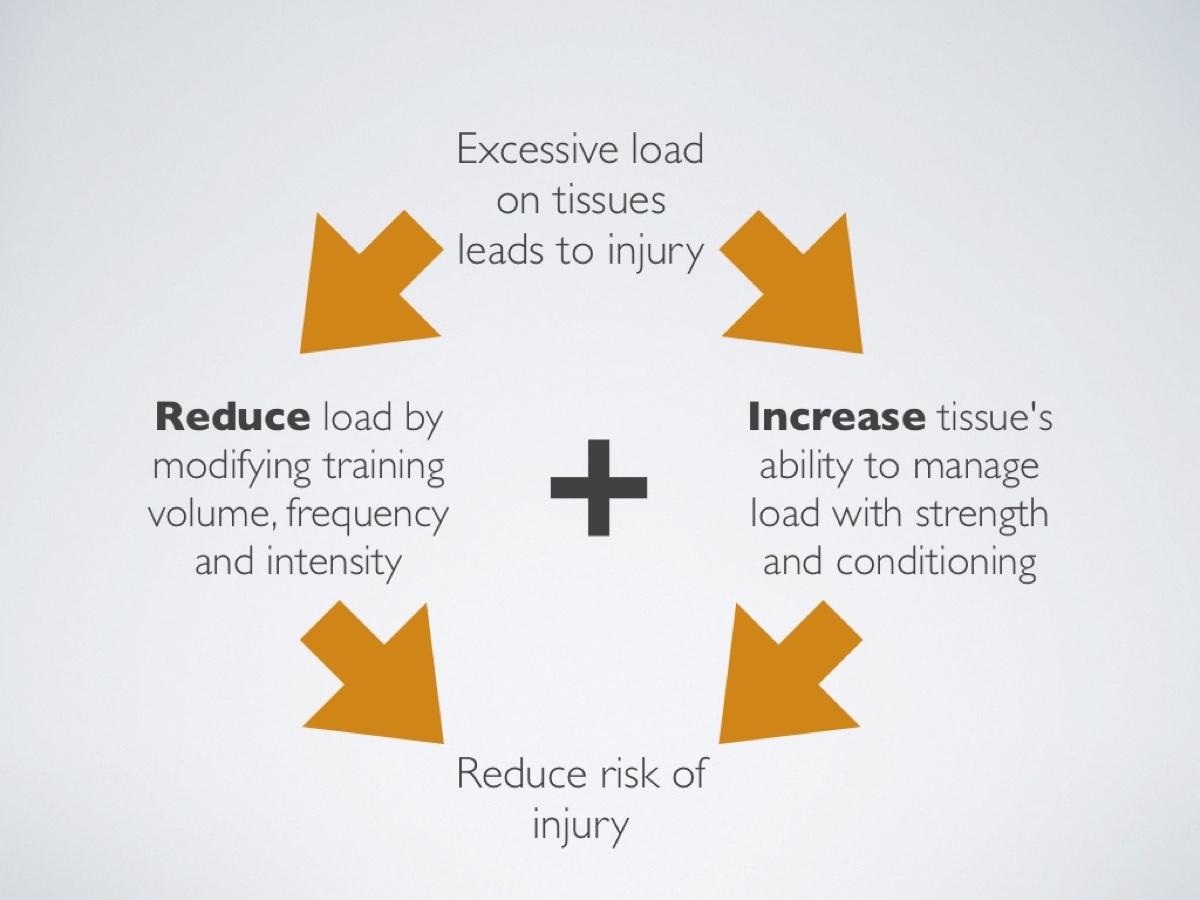
By modifying the load you place on your body while increasing your tissue’s ability to manage that load (and progressively more load), you can reduce your injury risk. Image: Running-physio.com/strength-review/
Strength Training for the Aging Endurance Runner
When it comes to aging and declining endurance-running performance, naturally decreasing muscle mass seems to be the main culprit. This is because there is a direct link between the age-related decrease in VO2max and muscle-mass loss. This age-related muscle-mass loss is called sarcopenia, and it starts somewhere just north of age 40 and accelerates rapidly after 70. Between the ages of 40 and 80 and with no intervention, you should expect to naturally lose approximately 40% of your muscle tissue.
Let’s dig into this concept with an example to help us understand it better, a 160-pound male endurance runner who is composed of 45% or 72 pounds of muscle. Between ages 40 and 80, we would expect our example runner to naturally lose 40% or 28.8 pounds of that muscle, what equates to 0.72 pounds per year.
Of note is that the muscle-loss-during-aging process isn’t linear and it generally accelerates as we age. Also of note is that muscle loss in the aging woman appears to happen at a slightly increased rate than men, and is likely why we see a larger decline in 100-kilometer performance for women over the age of 64 compared to their male counterparts (9).
What this means for our aging athletes is that strength training to maintain and build muscle mass is incredibly important. The current, best treatment for sarcopenia is strength training. The general recommendation is that if you are over the age of 40 and not currently strength training, we should probably change that.
That said, there are currently no clear, specific prescriptions for concurrent strength and endurance training for the aging endurance runner beyond what exists for all endurance runners. What we do know is that if you are currently doing a 3:1 ratio of endurance to strength training sessions, then you will probably maintain your muscle mass. Again, the potential, logical next step for an older endurance runner who wants to build muscle mass would be to increase the number of strength sessions, slightly skewing the ratio in favor of strength training (a 2:1 ratio, for example).
The Takeaways
Ease In
The first two to three weeks of strength training should be easier, to both avoid injury and not be chronically sore. One tactic is to introduce strength training at the end of your season, after you’ve taken a break and are starting to rebuild for the next year and when endurance training is of less importance. This allows your body to make strength-training adaptations without inhibiting your endurance training.
Dosage Matters
Studies suggest that low volume (less than six weeks of training and not multi-exercise based) and/or low intensity (less than 60% of your one-repetition maximum) strength training do not elicit any positive effects beyond your normal endurance training (1). Essentially strength-training plans that consist of lifting very low weights for more than 15 repetitions will not illicit the positive effects we talk about in this article. Current recommendations for concurrent strength and endurance training places us at using weight that is 70%-plus of our one-repetition maximum (1RM) for 5 to 12 repetitions in 3 sets and with adequate rest in between sets.
I’ve included a chart below to help you estimate workloads that are equivalent to different percentages of your 1RM. For most of us, without the supervision of a strength and conditioning professional, performing a true 1RM effort can lead to injury, so instead I recommend using a method of estimation. For example, a load that you can maximally lift for 12 repetitions is approximately 70% of your 1RM and a load that you can maximally lift for 8 repetitions is approximately 80% of your 1RM. Remember, strength training is supposed to be a progressive increase in load, so in the early weeks choose loads you can lift for 12 repetitions and gradually work up to loads you can only lift for 5 repetitions.
We recommend that to get the most bang for your buck, if you are going to add strength training to your week, you add two sessions a week focusing on 4 to 6 exercises at or above 70% of 1RM (a weight you cannot lift for more than 12 repetitions), and maintain your strength programming for a minimum of 6 to 9 weeks. Also don’t forget about that recommended ratio of 3:1 endurance to strength training sessions per week, so if you’re strength training twice a week make sure you’re doing 6 endurance training sessions a week as well.
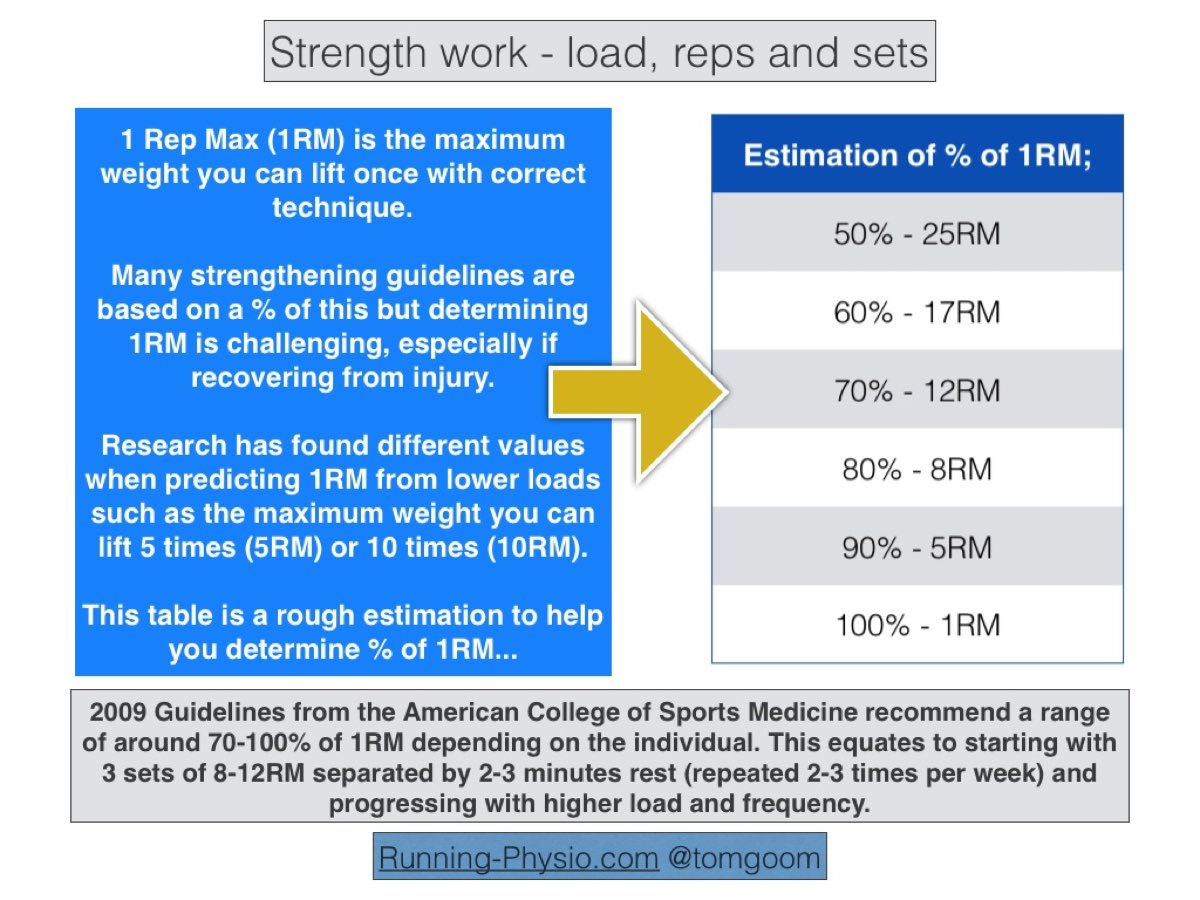
Safely doing one-repetition maximum (1RM) for a given exercise comes at an increased injury risk. Here are some approximations to understand what 70%-plus of 1RM might be for you. This means choosing a weight that you can manage for 5 to 12 repetitions. Remember, strength training is about progressively increasing load over time, so start with a lighter load you can lift for more repetitions and build into lifting heavier weights for fewer repetitions. Image: Running-physio.com/strength-review/
Type Matters
When choosing exercises to add to your strength program, focus on multi-joint exercises that use free weights (not machine-based) as they provide a much larger neuromuscular stimulus, require greater levels of coordination and multi-planar control, and activate synergistic muscle groups (4). Exercises that fit this bill include back squats, split squats, walking lunges, weighted step-ups, Romanian deadlifts, bird-dogs, kettlebell carries, and lateral lunges.
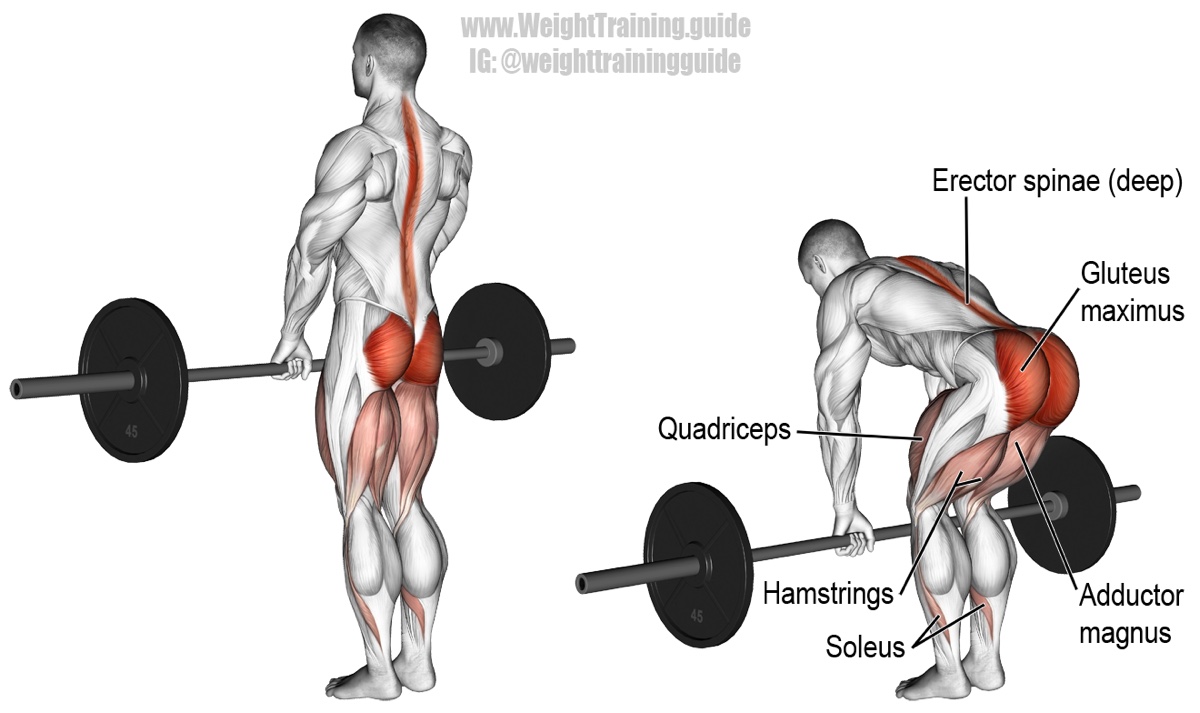
An example of a Romanian deadlift. Keep your back straight, hinge forward from your hips, push your butt back (not down) until you feel a slight stretch in your hamstrings, and then return to your starting position. Image: Weighttraining.guide/exercises/romanian-deadlift/
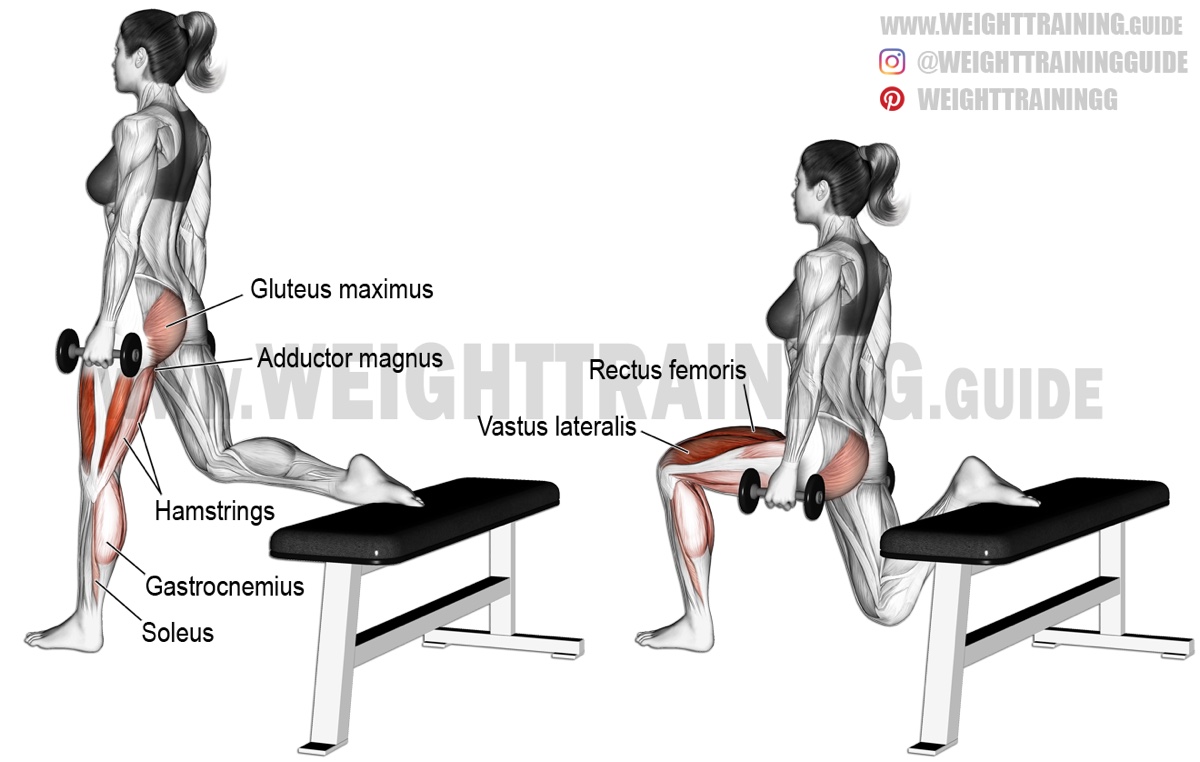
An example of a split squat utilizing dumbbells and your back foot on a bench, lunging forward until your knee is at a 90-degree angle, with your front knee remaining over your toes. Image: Weighttraining.guide/exercises/dumbbell-one-leg-split-squat/
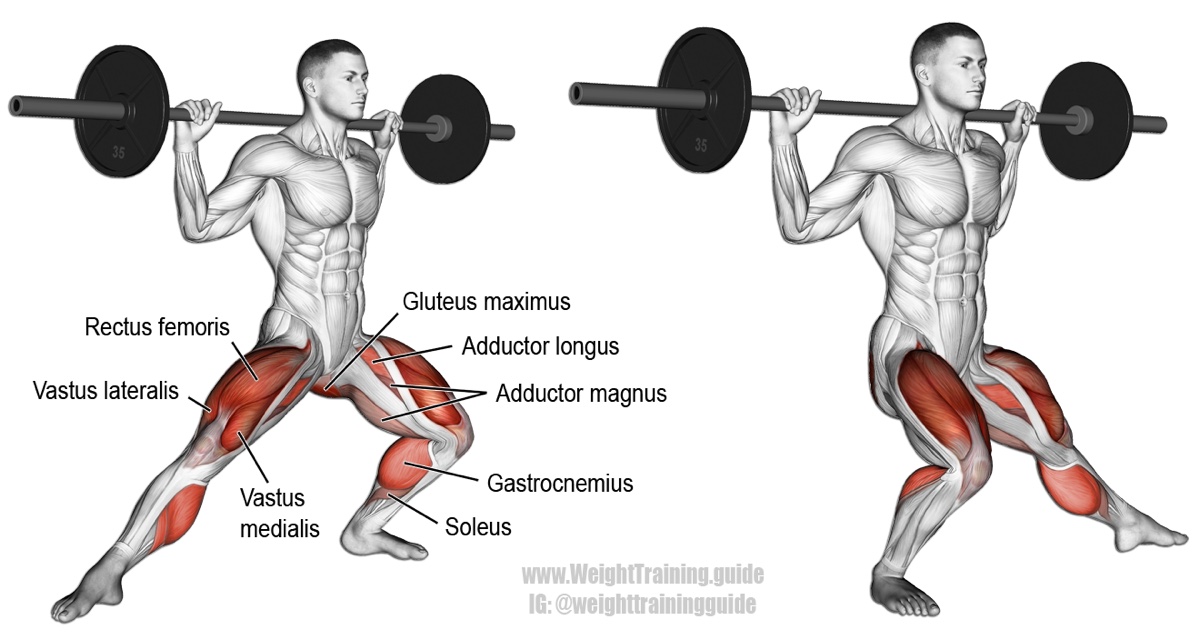
An example of a side lunge. This can be done with a barbell as depicted here or with a kettlebell held against the chest. Image: Weighttraining.guide/exercises/barbell-side-lunge/
Timing Matters
Remember that strength training for the purpose of stimulating physiological adaptations is not easy, and therefore in’t recommended for rest or easy days in your endurance-training schedule. In the eyes of weekly planning, I recommend pairing your strength training with your hard workout day(s), thus keeping your easy days easy and your hard days hard. As a bonus, heavy strength training also elicits a hormonal response including an increase in testosterone released (18). This can piggyback off your harder running workout for added muscular recovery. To preserve the quality of your running workouts, I’d place the endurance training in the morning and the strength training in the afternoon, and then give yourself one or two easy days in between that and your next hard workout (2).
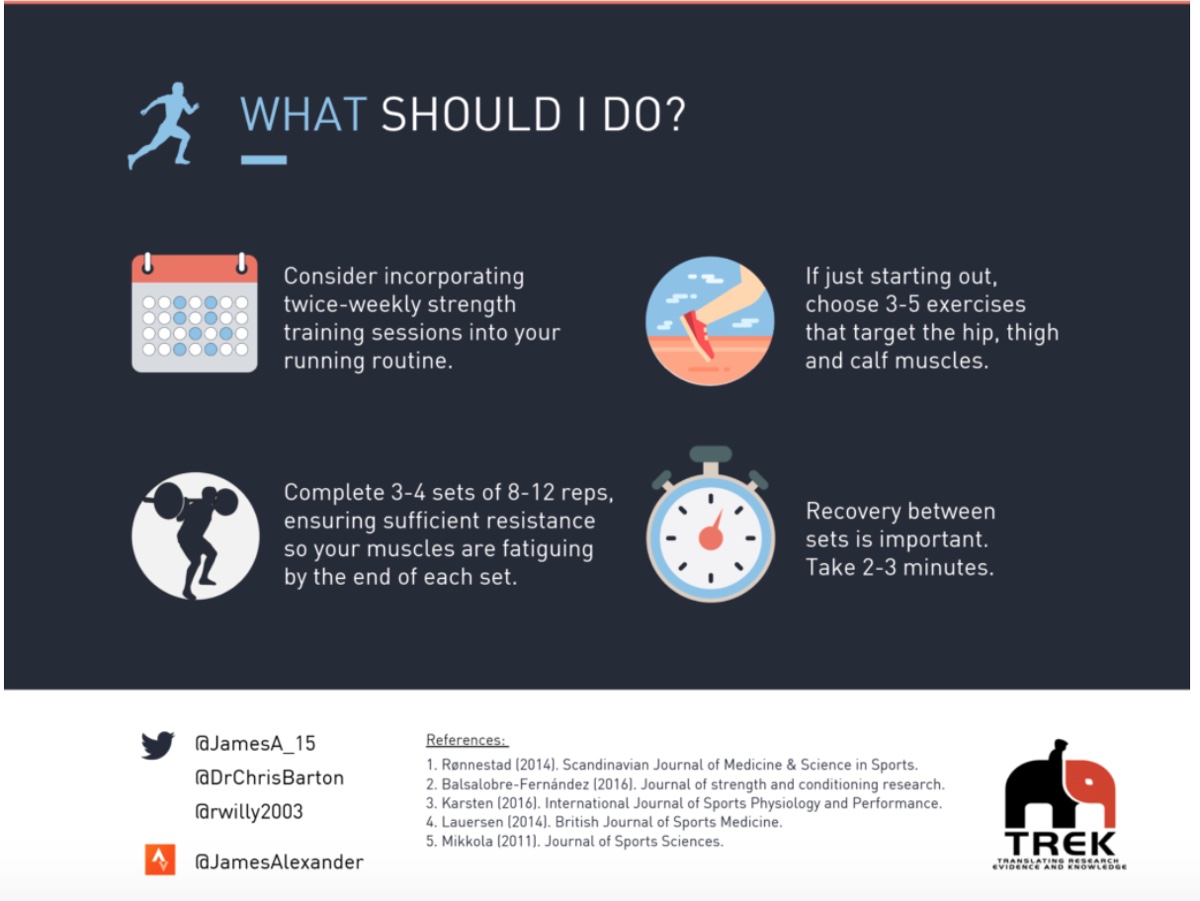
Recommendations for incorporating strength into your endurance training. Image: Semrc.blogs.latrobe.edu.au/running-myth-high-repetition-strength-training-needed-improve-running-performance/
Call for Comments (from Meghan)
- Do you strength train? What is your general ratio of endurance to strength training of the course of a week? What exercises do you do?
- Are you an endurance runner who has used strength training to avoid injury in general or maintain muscle mass as you age?
- Have you found any difficulties in maintaining concurrent endurance and strength training?
- Have you found your strength-training needs to evolve over your years as an endurance athlete?
References
- Aagaard, P., & Andersen, J. L. (2010). Effects of strength training on endurance capacity in top-level endurance athletes. Scandinavian Journal of Medicine & Science in Sports, 20, 39–47. doi: 10.1111/j.1600-0838.2010.01197.x
- Balsalobre-Fernández, C., Santos-Concejero, J., & Grivas, G. V. (2016). Effects of Strength Training on Running Economy in Highly Trained Runners. Journal of Strength and Conditioning Research, 30(8), 2361–2368. doi: 10.1519/jsc.0000000000001316
- Barnes, K. R., Mcguigan, M. R., & Kilding, A. E. (2014). Lower-Body Determinants of Running Economy in Male and Female Distance Runners. Journal of Strength and Conditioning Research, 28(5), 1289–1297. doi: 10.1519/jsc.0000000000000267
- Blagrove, R. C., Howatson, G., & Hayes, P. R. (2017). Effects of Strength Training on the Physiological Determinants of Middle- and Long-Distance Running Performance: A Systematic Review. Sports Medicine, 48(5), 1117–1149. doi: 10.1007/s40279-017-0835-7
- Carroll, K. M., Bazyler, C. D., Bernards, J. R., Taber, C. B., Stuart, C. A., Deweese, B. H., … Stone, M. H. (2019). Skeletal Muscle Fiber Adaptations Following Resistance Training Using Repetition Maximums or Relative Intensity. Sports, 7(7), 169. doi: 10.3390/sports7070169
- (2012). Commentaries on Viewpoint: Sacrificing economy to improve running performance—a reality in the ultramarathon? Journal of Applied Physiology, 113(3), 510–512. doi: 10.1152/japplphysiol.00666.2012
- Giovanelli, N., Taboga, P., Rejc, E., & Lazzer, S. (2017). Effects of strength, explosive and plyometric training on energy cost of running in ultra-endurance athletes. European Journal of Sport Science, 17(7), 805–813. doi: 10.1080/17461391.2017.1305454
- Karsten, B., Stevens, L., Colpus, M., Larumbe-Zabala, E., & Naclerio, F. (2016). The Effects of Sport-Specific Maximal Strength and Conditioning Training on Critical Velocity, Anaerobic Running Distance, and 5-km Race Performance. International Journal of Sports Physiology and Performance, 11(1), 80–85. doi: 10.1123/ijspp.2014-0559
- Knechtle, B., Rüst, C. A., Rosemann, T., & Lepers, R. (2011). Age-related changes in 100-km ultra-marathon running performance. Age, 34(4), 1033–1045. doi: 10.1007/s11357-011-9290-9
- Lauersen, J. B., Andersen, T. E., & Andersen, L. B. (2018). Strength training as superior, dose-dependent and safe prevention of acute and overuse sports injuries: a systematic review, qualitative analysis and meta-analysis. British Journal of Sports Medicine, 52(24), 1557–1563. doi: 10.1136/bjsports-2018-099078
- Luckin, K. M., Badenhorst, C. E., Cripps, A. J., Landers, G. J., Merrells, R. J., Bulsara, M. K., & Hoyne, G. F. (2018). Strength Training in Long-Distance Triathletes. Journal of Strength and Conditioning Research, 1. doi: 10.1519/jsc.0000000000002716
- Mikkola, J., Vesterinen, V., Taipale, R., Capostagno, B., Häkkinen, K., & Nummela, A. (2011). Effect of resistance training regimens on treadmill running and neuromuscular performance in recreational endurance runners. Journal of sports science, 29(13), 1359-1371.
- Pantoja, P. D., Morin, J. B., Peyré-Tartaruga, L. A., & Brisswalter, J. (2016). Running Energy Cost and Spring-Mass Behavior in Young versus Older Trained Athletes. Medicine & Science in Sports & Exercise, 48(9), 1779–1786. doi: 10.1249/mss.0000000000000959
- Rogers, M. E., Fujita, E., Islam, M. M., & Takeshima, N. (2017). Muscle strength and size gains in older women after four and eight weeks of high-intensity resistance training. International Journal of Sport, Exercise, and Health Research, 1(1), 22–28.
- Rønnestad, B. R., & Mujika, I. (2013). Optimizing strength training for running and cycling endurance performance: A review. Scandinavian Journal of Medicine & Science in Sports, 24(4), 603–612. doi: 10.1111/sms.12104
- Sunde, A., Støren, Ø., Bjerkaas, M., Larsen, M. H., Hoff, J., & Helgerud, J. (2010). Maximal Strength Training Improves Cycling Economy in Competitive Cyclists. Journal of Strength and Conditioning Research, 24(8), 2157–2165. doi: 10.1519/jsc.0b013e3181aeb16a
- Vikmoen, O., Raastad, T., Seynnes, O., Bergstrøm, K., Ellefsen, S., & Rønnestad, B. R. (2016). Effects of Heavy Strength Training on Running Performance and Determinants of Running Performance in Female Endurance Athletes. Plos One, 11(3). doi: 10.1371/journal.pone.0150799
- Rosa, C., Vilaça-Alves, J., Fernandes, H. M., Saavedra, F. J., Pinto, R. S., & Reis, V. M. D. (2015). Order Effects of Combined Strength and Endurance Training on Testosterone, Cortisol, Growth Hormone, and IGF-1 Binding Protein 3 in Concurrently Trained Men.Journal of Strength and Conditioning Research, 29(1), 74–79. doi: 10.1519/jsc.0000000000000610
- Hickson, R. C. (1980). Interference of strength development by simultaneously training for strength and endurance.European Journal of Applied Physiology and Occupational Physiology, 45(2-3), 255–263. doi: 10.1007/bf00421333
